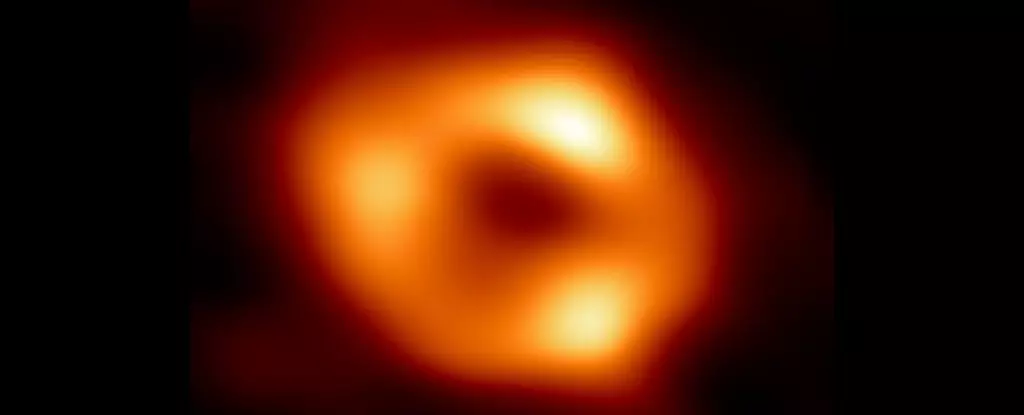The groundbreaking image of Sagittarius A* (Sgr A*), the supermassive black hole at the center of the Milky Way, introduced in 2022, has now faced scrutiny and reinterpretation. Researchers from the National Astronomical Observatory of Japan (NAOJ) have challenged the conventional spherical representation of the black hole’s accretion disk, suggesting that it may instead exhibit a more elongated shape. This revelation opens pathways for a deeper understanding of black holes, their behavior, and the intricate dance of matter that surrounds them.
The Initial Rendering of Sgr A*
When the Event Horizon Telescope (EHT) collaboration released its iconic image of Sgr A*, it was hailed as a monumental achievement in astrophysics. The image displayed a mesmerizing ring-like structure enveloping a dark void, visually reinforcing theoretical models of black holes. Significantly, this representation was the first of its kind, collated from a global array of eight radio telescopes, providing a glimpse into the enigmatic nature of black holes. However, this original portrayal, while groundbreaking, could have been influenced by the challenges inherent in analyzing complex radio interferometry data.
NAOJ astronomer Miyoshi Mikato states that the completed product, the EHT image, may have consciousness of imperfections in analysis techniques and imaging methods. This sparks critical questions about the reliability of data derived from high-technology instruments. The implications of the original “bright ring” could be artful constructs rather than a faithful rendering of reality, driving researchers to re-examine these findings.
The NAOJ team applied different analytical approaches to the EHT data and concluded that the physical structure surrounding Sgr A* is less of a perfect circle and more of an elongated shape. According to their findings, this elongated appearance suggests active dynamics in the accretion disk, hinting that the matter spiraling into the black hole may be rotating at approximately 60% of the speed of light. This interpretation breaks ground on several fronts, offering new insights into the dynamics of black holes and how they interact with their environments.
The more nuanced image provided by NAOJ highlights discrepancies in brightness within the disk itself. The eastern half appears markedly brighter than its western counterpart. Researchers attribute this luminance variation to a Doppler effect, where the fast rotation of the accretion disk enhances light from one side. This idea enriches our comprehension of how matter behaves in extreme gravitational fields and under high velocities.
It’s crucial to recognize that both interpretations—EHT’s circular vision and NAOJ’s elongated model—could coexist accurately, each contributing distinct insights. As Mikato points out, achieving a flawless astronomical image is a formidable challenge. The EHT data, derived from interconnected telescopes, often contains gaps and inconsistencies. Addressing these challenges is integral to astrophysical imaging.
The way different teams handle this inherent “noise” and the techniques employed to synthesize complete images can lead to varying conclusions. While EHT’s original image adopted a method that yielded a circular structure, the NAOJ team embraced an alternative technique that rendered this revised elongated view. These contrasting methodologies reveal how interpretation plays a significant role in our understanding of celestial phenomena.
The revelation from the NAOJ signifies more than a reinterpretation of an image. It touches on the broader scientific narrative that involves continuous refinement of our methods and perspectives concerning black holes. The image released by the EHT consortium opened doors to new questions, urging researchers to delve deeper into the behaviors and structures surrounding supermassive black holes.
As scientists become increasingly aware of the limitations and geometrical influences on imaging, efforts are underway to apply more advanced analytical approaches, which may eventually lead to finer representations. The collaboration across institutions not only enhances data analysis but also strengthens our grasp of the complexities of black hole environments. The ultimate objective remains clear: to unearth a more comprehensive understanding of how supermassive black holes shape galaxies and influence cosmic evolution.
The NAOJ’s fresh interpretation of the accretion disk surrounding Sgr A* underscores the necessity for continual reassessment and innovation in the field of astrophysics. Each revelation prompts further exploration and discussion, ultimately driving the quest for knowledge about the universe’s most mysterious entities. With ongoing research efforts, a more profound comprehension of black holes may soon materialize, enriching our cosmic narrative.

